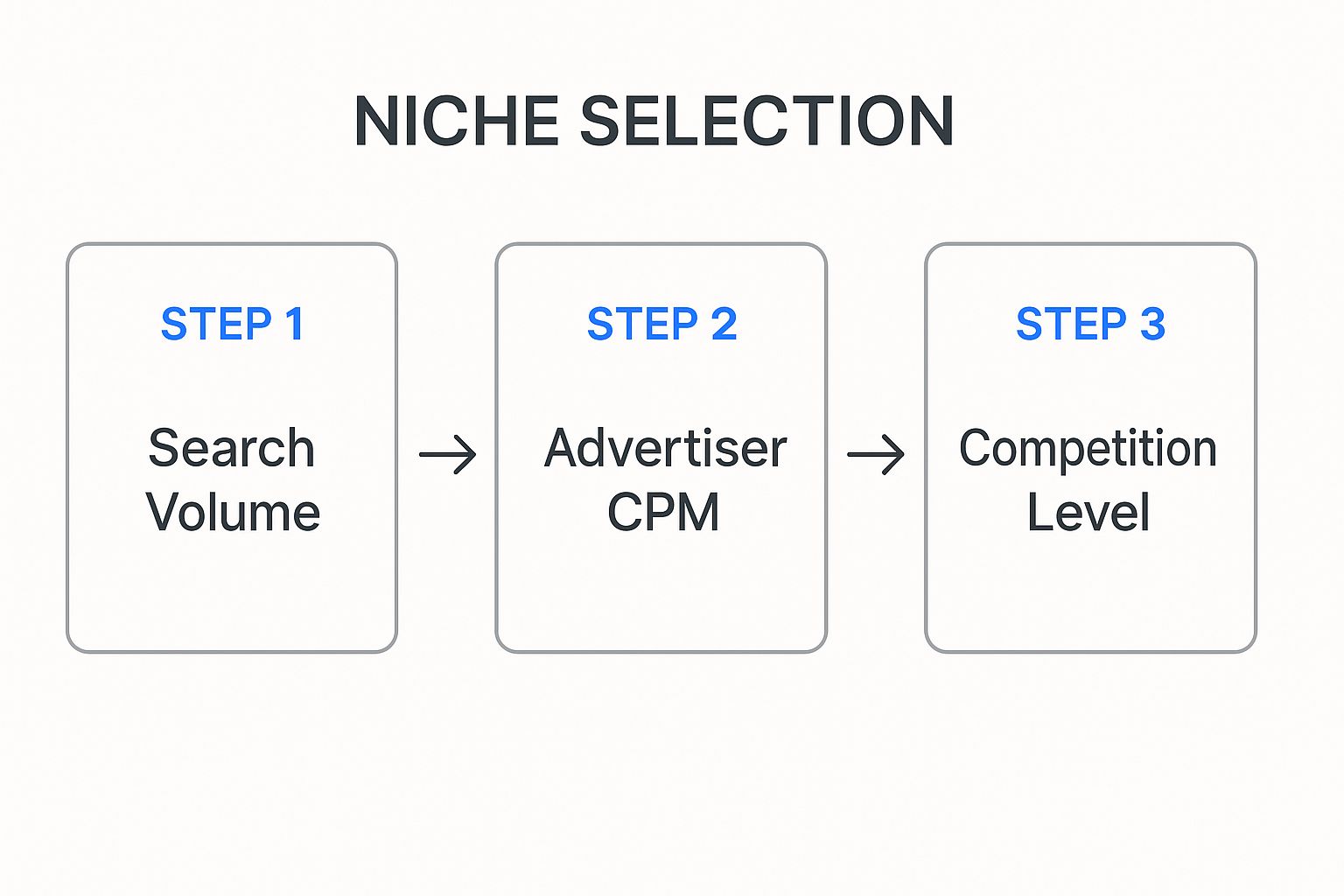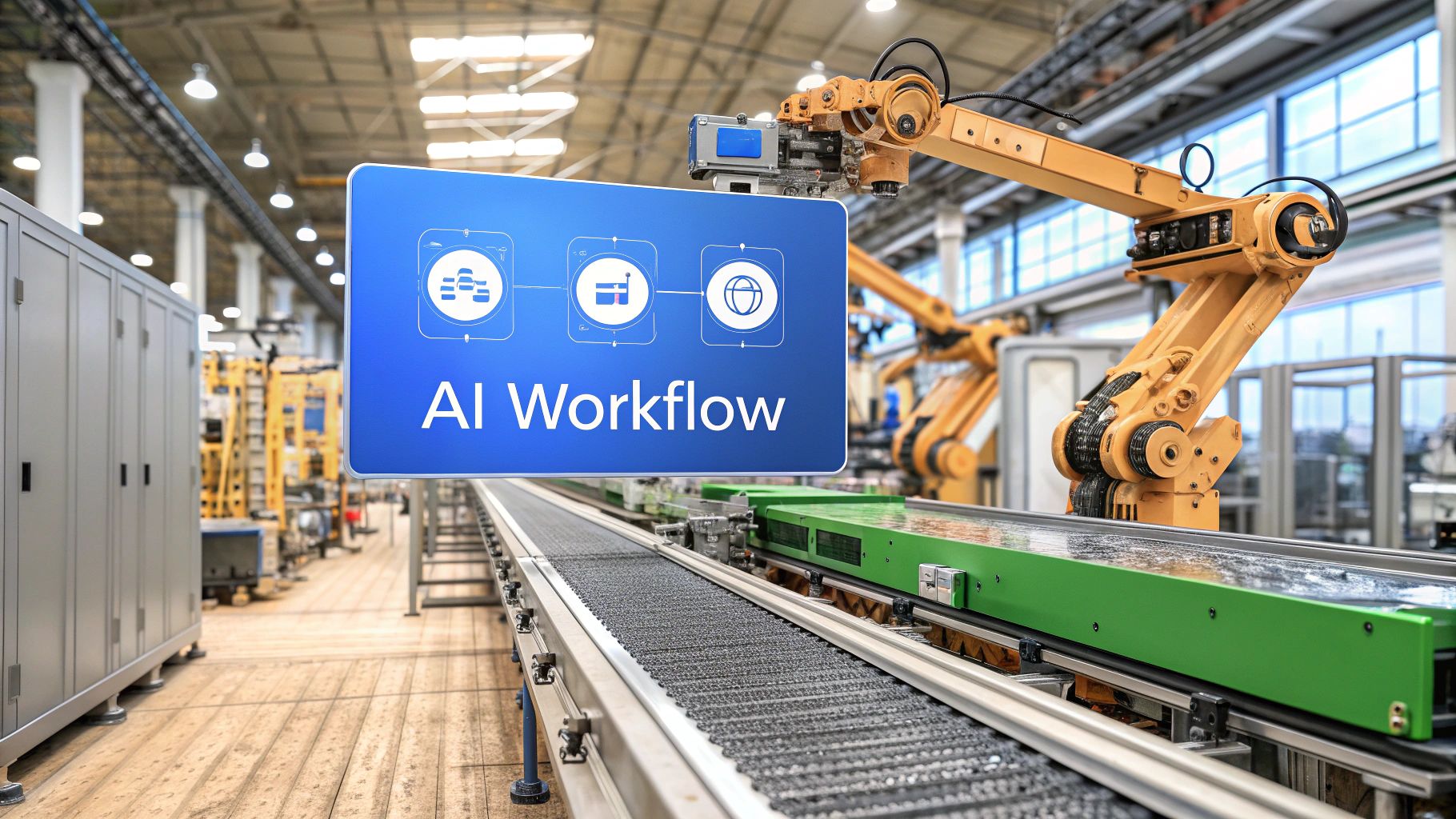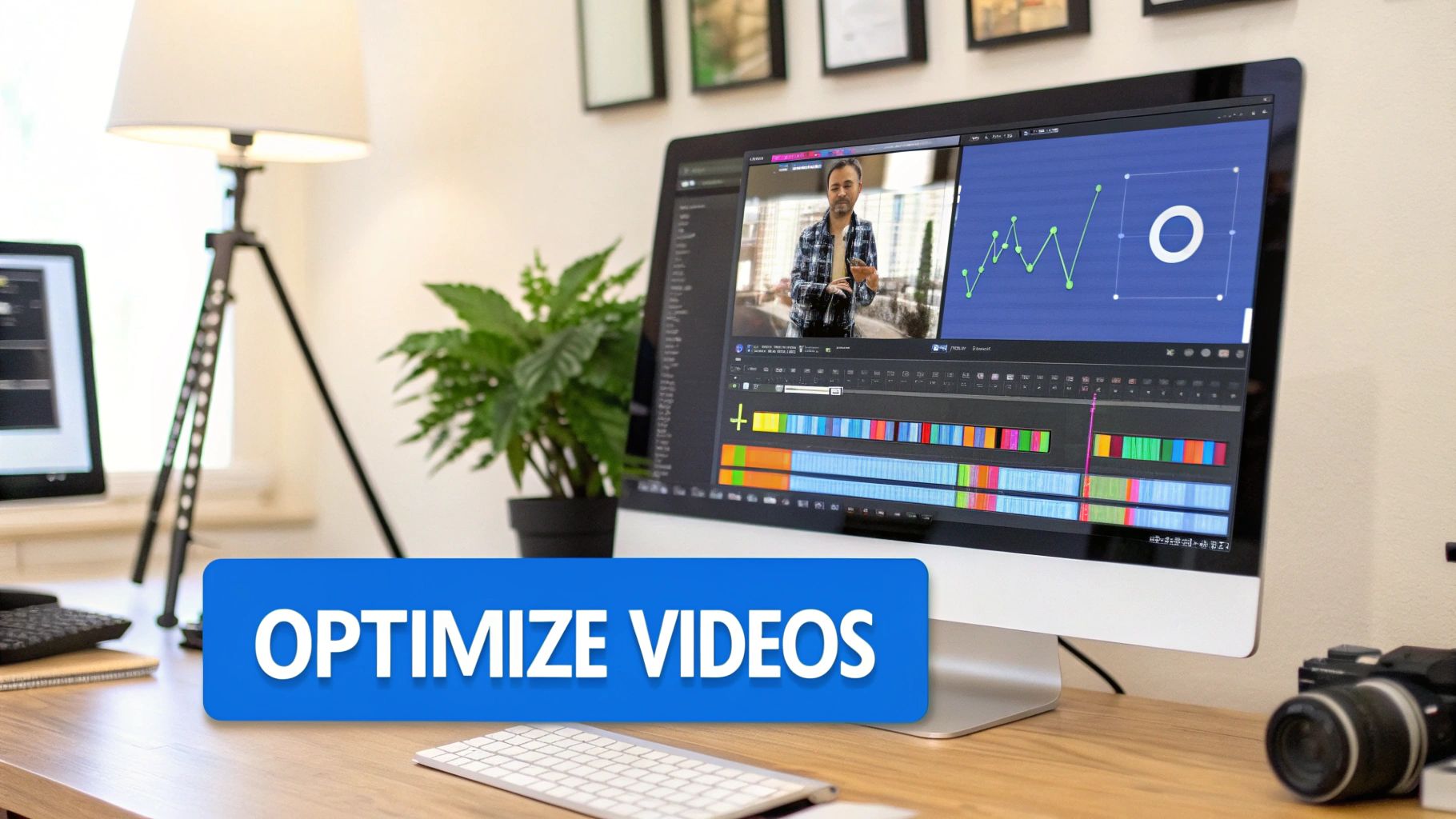So, you want to get into YouTube automation. The basic idea is to build a system that can script, generate, and publish videos automatically, all without you ever needing to show your face on camera. It’s about setting up a content assembly line for a "faceless" channel, using smart tools to handle the heavy lifting. This lets you scale up your video production in a way that just isn't possible when you're doing everything by hand.
What YouTube Automation Really Means

Let’s cut through the noise. YouTube automation isn’t some magic button you press for instant cash. It's a legitimate business model for scaling video content, letting you run one or even multiple channels without being the star of the show. You’re shifting your role from a hands-on creator to more of a strategist or system manager.
Instead of burning hours scripting, recording, and editing every single video, you build a workflow. This system leverages a stack of specialized tools—and sometimes freelancers—to do the hard work for you. The end goal? To pump out consistent, high-quality content efficiently, which frees you up to focus on the big picture: growth, strategy, and monetization.
The Modern Automation Workflow
Think of it like a well-oiled machine. Each step in the content creation process is optimized for speed and quality, giving you a predictable and scalable output. This is how you compete on a platform as massive as YouTube.
Below is a breakdown of what this modern workflow typically looks like. Each stage has a clear objective and relies on specific types of tools to get the job done right.
The Modern YouTube Automation Workflow
| Stage | Core Objective | Example Tools and Platforms |
|---|---|---|
| Ideation & Research | Find profitable topics with high viewer interest and low competition. | VidIQ, TubeBuddy, Google Trends |
| AI Scripting | Generate well-structured, engaging scripts in a fraction of the time. | Jasper, Copy.ai, ChatGPT |
| Visual & Audio Generation | Create video footage and realistic AI voiceovers without a camera or mic. | ShortsNinja, Synthesia, Murf.ai |
| Scheduling & Publishing | Automate the upload process to maintain a consistent posting schedule. | Native YouTube Scheduler, Hootsuite |
This table gives you a bird's-eye view of the system you're building. By plugging the right tools into each stage, you create a powerful engine for content production.
As of 2025, YouTube’s audience has swelled to 2.5 billion monthly active users, solidifying its spot as the world's second-largest search engine right behind Google. This massive user base has fueled the rise of YouTube automation, as creators look for ways to keep up. The field is getting crowded, with tens of thousands of channels, especially in niches like tech tutorials and personal finance, now relying on automated systems.
A lot of people get hung up on the term "YouTube automation." A better way to think about it is "YouTube Management." You're still the director, making all the key decisions. The difference is you're managing a system of tools and processes instead of doing every single task yourself.
Ultimately, mastering YouTube automation comes down to understanding each piece of this system. From picking a winning niche to digging into your analytics, it requires a strategic mindset. To get a better handle on the core concepts, check out our guide on what is workflow automation. This article will give you the roadmap you need to build your own successful channel from the ground up.
Finding a Niche Built for Automation
Let's be blunt: choosing your niche is the single most important decision you'll make. Get this right, and you're setting yourself up for a profitable, low-effort channel. Get it wrong, and you'll spend months churning out videos for an audience of three people (and two of them are probably you).
The goal isn't just to find something popular. It's to find a topic that's both in-demand and a perfect fit for faceless, automated content. That means we need to look past flashy trends and dig into what actually works for this specific business model.
Identifying High-Value Topics
Your search starts with a term you need to burn into your brain: Cost Per Mille (CPM). This is how much advertisers are willing to pay for every 1,000 views on your videos. A channel about celebrity gossip might get a $2 CPM, while a channel breaking down stock market trends could pull in $20. See the difference?
We're hunting for high-CPM niches. Think personal finance, crypto explainers, tech tutorials, and deep-dive educational content. These topics attract audiences with buying power, and that's exactly who advertisers want to reach.
A great automation-friendly niche usually has these traits:
- It’s information-heavy. Topics you can explain with stock footage, animations, and screen recordings are perfect. Think "How Does Blockchain Work?" not "My Trip to Bali."
- It has evergreen demand. Sure, jumping on a trend is great for a quick traffic spike, but your real money comes from videos that pull in views for months—or even years—after you publish them.
- It has a crystal-clear audience. When you know exactly who you're talking to (e.g., beginner investors, software developers, DIY homeowners), your content becomes laser-focused, making your channel irresistible to advertisers targeting that group.
The infographic below breaks down the sweet spot you're looking for.

It's all about finding that perfect intersection of high search volume, big advertiser budgets, and competition you can actually beat.
Using Data to Validate Your Niche
Guessing is for amateurs. Successful YouTube automation is a game of data, not passion projects. The channels quietly making a killing are operating in specific, data-backed niches where advertiser demand is through the roof.
For example, looking ahead to 2025, channels covering AI tutorials or personal finance for retirees are commanding CPMs between $10–$25 in English-speaking markets. That absolutely dwarfs the platform average of $2–$5. The reason is simple: these topics attract an audience with money to spend. To find these goldmines, over 50% of serious creators are using tools like VidIQ and Google Trends to spot viral subjects before they blow up. You can learn more about the best niches for YouTube automation.
Don't fall into the trap of picking a niche just because you see a few big channels crushing it. That's a recipe for getting lost in an oversaturated market. Instead, use data to find a unique angle or a sub-niche that nobody is serving properly yet.
Instead of a generic "wealth" channel, drill down. Think "Side Hustles for College Students" or "Index Fund Investing for Beginners." These hyper-specific topics have way less competition, allowing you to quickly become the go-to expert for a loyal, dedicated audience. That's how you build momentum and create a real asset.
Building Your AI Content Assembly Line
This is where the real fun begins. Forget spending hours behind a camera or in front of a microphone. We're about to build a slick, automated system that cranks out high-quality videos for you. Your job is about to shift from hands-on creator to a savvy operator who just oversees the machine.
The whole idea is to stack a few specific AI tools together, with each one handling a different part of the video creation process. Think of it like a factory line: one tool generates the ideas, another writes the script, and so on. It’s how you turn content creation from a chaotic art into a predictable science.
The Core Components of Your AI Workflow
To get your assembly line running, you need to know the key production stages. The good news is there’s a specialized AI tool for just about every step, turning simple text prompts into videos that actually get views.
Here’s a breakdown of the essential parts:
- AI Scripting: This is your starting point. Tools like ChatGPT or Jasper can take a vague idea and spin it into a full script. Just feed it a prompt like, "Write a 5-minute video script on the top 3 beginner-friendly investing strategies," and watch it work. You'll have a structured narrative in seconds.
- AI Voice Generation: Got your script? Great. Now, platforms like ElevenLabs or Murf.ai can generate incredibly natural-sounding voiceovers. You can pick from tons of different voices, accents, and tones until you find one that perfectly fits your channel's vibe.
- AI Video and Image Creation: This is where your video comes to life visually. Tools like RunwayML can generate video clips from text descriptions, and you can pull in stock media for B-roll. The trick is finding visuals that sync up perfectly with what the script is saying.
AI has completely taken over this space. It's estimated that over 60% of creators focused on automation are now using these tools for scripting, voiceovers, and editing. This is exactly why nearly 40% of new automation channels are "faceless," focusing on algorithm-friendly formats like listicles and explainer videos.
Streamlining with All-in-One Platforms
Juggling a bunch of different AI tools works, but it can get messy and time-consuming. This is where an all-in-one platform like ShortsNinja really shines. It pulls the entire workflow into one clean, simple system. No more bouncing between a scriptwriter, a voice generator, and a video editor.
With a tool like ShortsNinja, you can plug in an idea, and it will generate the script, create the voiceover, and produce the final video with AI-selected visuals—all in just a few clicks. It’s the ultimate content assembly line. If you're still figuring out your ideal tool stack, our guide on the top AI tools for content creators is a great place to start.
This screenshot gives you a peek into how different niches perform, which underscores why making data-driven decisions is so important for your content strategy.

As you can see, niches like finance and tech have much higher earning potential because advertisers are willing to pay more to reach those audiences.
When you build an efficient AI assembly line, you’re not just making videos. You're building a scalable digital asset. Your focus shifts from the tedious grunt work of production to high-level strategy, like picking the right topics and analyzing what’s working.
As you get your system humming, it’s smart to think a few steps ahead. Understanding how to master LLM SEO will help position your content for AI-driven search platforms. This kind of forward-thinking ensures your automated channel doesn't just work today, but stays competitive as technology keeps evolving.
Optimizing Your Videos for the Algorithm

Putting together a slick video with your AI assembly line is a great start, but it's only half the battle. If nobody ever finds your content, all that hard work goes down the drain. This is where you have to get surgical with your optimization. Treat every single video as a targeted asset, designed to grab the attention of both real viewers and the ever-watchful YouTube algorithm.
Think of the algorithm as a picky librarian trying to shelve a new book. It needs to know exactly what your video is about so it can recommend it to the right people. Your job is to feed it a steady diet of clear, consistent signals through your title, description, and tags. This isn't about mindlessly stuffing in keywords; it's about building a cohesive package that screams relevance from top to bottom.
Crafting Titles That Actually Get Clicks
Your video title is your first—and often your only—chance to make an impression. It has to be the perfect marriage of keyword-rich information and pure, unadulterated curiosity.
A title like "Investing Tips" is bland. It's boring. It will disappear into the YouTube void, never to be seen again. A much better approach? Something like, "3 Investing Mistakes Costing Beginners Thousands."
See the difference? This title works because it:
- Targets a specific audience: It calls out "beginners" right in the title.
- Creates urgency: The phrase "costing thousands" triggers a little bit of FOMO (fear of missing out).
- Uses a number: List-based titles are psychologically proven to attract more eyeballs and clicks.
So many automated channels fail because they feel soulless and robotic. Even when the content is AI-generated, your title must connect on a human level by tapping into a real problem or desire. It’s the hook that reels them in.
Writing Descriptions and Tags That Matter
The video description is your chance to give the algorithm all the juicy context it craves. Don't just toss in a sentence or two and call it a day. Aim for a detailed, 200-300 word summary of your video. Weave in your main keyword and a few related secondary keywords naturally. Think of it as a mini-blog post that spells out the value a viewer is about to get.
Your description should be written for a human first, but structured for the algorithm. Use your primary keyword within the first two sentences, then expand with related terms throughout the text.
Tags aren't as powerful as they once were, but they still play a role in helping YouTube categorize your content. Use a healthy mix of broad and specific tags. For our investing video example, you might use:
- Broad Tags: "investing," "personal finance," "stock market"
- Specific Tags: "investing for beginners," "how to start investing," "common investing mistakes"
This combination helps YouTube understand both the general category and the specific niche your video fits into. If you're struggling to come up with the right keywords, our guide on the best AI tools for YouTube keyword trends can give you a serious edge.
At the end of the day, consistent and thoughtful optimization is what separates the successful automated channels from the ones that fizzle out before they ever get going.
Using Data to Scale Your Operation
One of the biggest myths about YouTube automation is that it's a ‘set it and forget it’ deal. That couldn't be further from the truth. The most successful automated channels are built on a foundation of data. Once your content machine is humming along, your job switches from producer to analyst. You have to learn to read the story your YouTube Analytics is telling.
https://www.youtube.com/embed/7n9hBmA-oCY
Ignoring your analytics is like trying to drive blindfolded. You might inch forward for a bit, but you have no clue where you're going or why. The channels that truly crush it treat their operation like a business, constantly refining their strategy based on hard numbers, not just a gut feeling.
This means getting obsessed with a few core metrics. Forget vanity numbers like subscriber counts for a moment. We need to focus on what actually moves the needle.
The Metrics That Truly Matter
To really dial in your process, you need a simple dashboard of key performance indicators. These are the numbers that tell you exactly how viewers are reacting to your videos and, just as importantly, what the algorithm thinks of your content.
Here are the vital signs I track for every automated channel.
Key Metrics for Your Automation Dashboard
To make sense of your channel's performance, you need to focus on the right numbers. This table breaks down the most critical metrics, what they mean for your strategy, and the benchmarks you should be aiming for.
| Metric | What It Tells You | Target Benchmark |
|---|---|---|
| Click-Through Rate (CTR) | How compelling your thumbnail and title are. A low CTR means your packaging isn't working. | Aim for 4-6% or higher in your first 24 hours. |
| Audience Retention | Whether your content is actually engaging. Steep drop-offs in the first 30 seconds are a major red flag. | Strive for 40%+ average retention for a 10-minute video. |
| Average View Duration | The average time people spend watching your videos. Higher is always better. | Anything above 50% of your video's total length is excellent. |
Tracking these metrics gives you a clear, actionable snapshot of what's working and what needs to be fixed in your content assembly line.
A high CTR paired with terrible audience retention is the classic signature of clickbait. You got the click, but the video didn't deliver on its promise. The algorithm hates this and will penalize your channel's long-term growth.
Get in the habit of A/B testing your thumbnails and titles. Before you publish, create two different versions and show them to a friend. Ask which one they’d click on and why. Tiny tweaks—a different color, a bolder font, a more intriguing question—can make a massive difference in your CTR.
Smart Scaling Strategies
Once you have a workflow that’s making money and you know how to read your data, it’s time to scale. This isn't just about churning out more videos; it's about making smarter investments with your profits.
Here’s how to do it right:
- Reinvest in Quality: Use your early earnings to upgrade from free AI tools to premium versions. A better AI voice generator or a more capable video creation suite like ShortsNinja can give your production value a serious boost.
- Outsource Your Bottlenecks: If you’re spending hours agonizing over thumbnails, hire a pro on a site like Fiverr. Offloading a single, high-impact task frees you up to focus on the big-picture strategy.
- Launch a Second Channel: Once you’ve perfected your system, don’t just sit on it. Replicate it in a completely different niche. Your proven workflow is now a template you can use to build multiple income-generating assets.
Scaling your YouTube automation channel is a calculated game. It’s all about analyzing your performance, finding the weak spots, and strategically putting your resources back into the machine to build a stronger, more profitable operation.
Common Questions About YouTube Automation
Jumping into YouTube automation usually sparks a ton of questions. It's totally normal to feel a mix of excitement and "am I really doing this right?" when you're building something new from scratch. So, let's clear the air and tackle the big questions that pop up for almost every new creator.
This isn't about finding a magic bullet. It's about understanding the business model behind these channels so you can make smart, strategic moves from day one. Knowing what you're getting into is the first step to building a channel that actually lasts.
Is YouTube Automation Against the Rules?
This is probably the biggest myth out there. The short answer is no, YouTube automation is perfectly fine as long as you're playing by YouTube's Community Guidelines. The word "automation" just means you're using tools to make your workflow more efficient—it's not a green light to pump out spammy, low-effort videos.
As long as your content is original, actually gives viewers something of value, and doesn't try to trick people, using AI for scripts, voiceovers, or editing is completely compliant. The goal is always to create quality content, no matter what tools you use to get there.
How Much Does It Really Cost to Start?
Your starting costs can be surprisingly low. You could genuinely get a channel up and running for under $100 a month if you're smart about mixing free and affordable AI tools. This bootstrap approach definitely works, but you might have to trade off some speed or polish in your final videos.
For a more professional setup—think premium AI voices, better video tools, and custom-designed thumbnails—a budget between $150 and $500+ per month is more realistic. Your investment is directly tied to the level of quality and efficiency you're shooting for.
Think of it like any business. You can start lean and reinvest your profits, or you can put more money in upfront to hit the ground running with higher production quality and faster growth.
How Long Until My Channel Makes Money?
This is where patience becomes your superpower. While you'll see stories of channels hitting it big in 3-6 months, a more grounded timeline to reach monetization—that magic number of 1,000 subscribers and 4,000 watch hours—is closer to 6-12 months of consistent work.
This is absolutely a marathon, not a sprint. Your timeline depends entirely on a few key things:
- Your Niche: Choosing a topic with high advertiser value (often called a high CPM) makes a huge difference.
- Content Quality: Your videos have to be good enough to keep people watching.
- Consistency: A steady publishing schedule tells the YouTube algorithm your channel is active and serious.
- Good SEO: You need to get your titles, descriptions, and tags right so people can actually find your videos.
Can I Do This with Zero Experience?
Yes, you absolutely can. One of the best things about this model is how it lowers the barrier to entry. You don't need to be a video editing guru or a natural on-camera personality. The whole process is built on systems and tools that are getting easier to use every single day.
That said, you do need to be willing to learn the ropes. That means getting a handle on niche research, learning the basics of YouTube SEO, and getting comfortable with whatever software you choose. This guide gives you the roadmap, but your commitment to learning and adapting is what will ultimately drive your success.
Ready to build your own AI content assembly line without the hassle of juggling multiple tools? ShortsNinja combines scripting, voice generation, and AI visuals into one seamless platform. Start creating high-quality, faceless videos in minutes.

